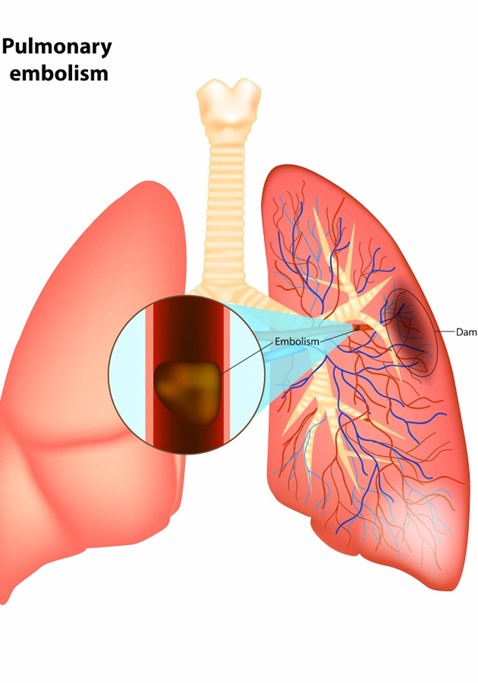Days after surgical fixation of a fractured femur, a client suddenly reports chest pain and difficulty in breathing. The nurse suspects that the client had a pulmonary embolus. Which action should the nurse take first?
Notify the healthcare provider.
Prepare a continuous heparin infusion per protocol.
Provide supplemental oxygen.
Bring the emergency crash cart to the bedside.
The Correct Answer is C
Choice C is correct because providing supplemental oxygen is the first action that the nurse should take for a client who has a suspected pulmonary embolus. A pulmonary embolus is a life-threatening condition that occurs when a blood clot travels to the lungs and blocks the blood flow, causing hypoxia and respiratory distress. The nurse should administer oxygen to improve the client's oxygenation and prevent further complications.
Choice A is incorrect because notifying the healthcare provider is not the first action that the nurse should take for a client who has a suspected pulmonary embolus. The nurse should notify the healthcare provider after providing supplemental oxygen and assessing the client's vital signs and symptoms.
Choice B is incorrect because preparing a continuous heparin infusion per protocol is not the first action that the nurse should take for a client who has a suspected pulmonary embolus. Heparin is an anticoagulant that can prevent further clot formation and reduce the risk of recurrence, but it does not dissolve existing clots or improve oxygenation. The nurse should prepare a heparin infusion after obtaining a prescription from the healthcare provider and confirming the diagnosis with diagnostic tests.
Choice D is incorrect because bringing the emergency crash cart to the bedside is not the first action that the nurse should take for a client who has a suspected pulmonary embolus. The emergency crash cart contains equipment and medications that can be used in case of cardiac arrest or other emergencies, but it does not address the immediate need of oxygenation. The nurse should bring the emergency crash cart to the bedside after providing supplemental oxygen and assessing the client's condition.

Nursing Test Bank
Naxlex Comprehensive Predictor Exams
Related Questions
Correct Answer is B
Explanation
Choice A: Ask for a consultation with a psychologist. This is not the best intervention, as it does not address the physical aspect of pain management. A psychologist may help the client cope with emotional distress and cognitive-behavioral strategies to reduce pain perception, but it may not be enough to relieve severe pain.
Choice B: Arrange an appointment with a pain specialist. This is the best intervention, as it addresses the physical aspect of pain management. A pain specialist may prescribe appropriate medications, perform interventional procedures, or recommend alternative therapies to relieve severe pain.
Choice C: Contact a hospice nurse for an evaluation. This is not the best intervention, as it does not address the eligibility criteria for hospice care. Hospice care is intended for clients who have a terminal illness with a life expectancy of six months or less, and who have decided to forego curative treatments. Fibromyalgia is not a terminal illness, and hospice care may not be appropriate for this client.
Choice D: Form an interdisciplinary team for evaluation. This is not the best intervention, as it does not address the urgency of pain management. An interdisciplinary team may consist of various healthcare professionals who can provide holistic care for the client, but it may take time to coordinate and implement their services.
Correct Answer is D
Explanation
Choice A: Advising the client to place one nitroglycerin tablet under his tongue as a precaution is a dangerous action for the nurse, as this can cause severe hypotension and cardiovascular collapse due to the interaction between tadalafil and nitroglycerin. This is a contraindicated choice.
Choice B: Telling the client to have someone bring him to an emergency department immediately is an unnecessary action for the nurse, as there is no evidence of any serious adverse reaction or complication from tadalafil. This is an overreaction choice.
Choice C: Instructing the client to increase his intake of oral fluids until the skin flushing is relieved is not an appropriate action for the nurse, as this does not address the cause of the flushing, which is vasodilation due to tadalafil. This is a distractor choice.
Choice D: Reassuring the client that skin flushing is a common side effect of the medication is an appropriate action for the nurse, as this can calm the client and educate him about the expected effects of tadalafil. Therefore, this is the correct choice.
Whether you are a student looking to ace your exams or a practicing nurse seeking to enhance your expertise , our nursing education contents will empower you with the confidence and competence to make a difference in the lives of patients and become a respected leader in the healthcare field.
Visit Naxlex, invest in your future and unlock endless possibilities with our unparalleled nursing education contents today
Report Wrong Answer on the Current Question
Do you disagree with the answer? If yes, what is your expected answer? Explain.
Kindly be descriptive with the issue you are facing.
